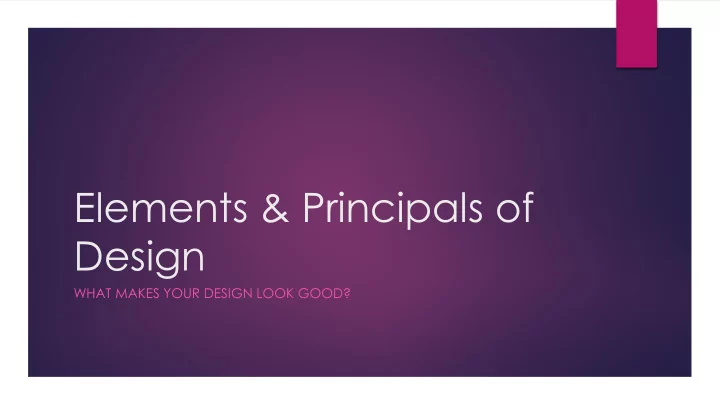

Elements & Principals of Design WHAT MAKES YOUR DESIGN LOOK GOOD?
Elements of COLOR Art LINE The elements of art SHAPE are the building FORM blocks of an artistic creation. SPACE TEXTURE
Color What is perceived when light hits and Color Schemes reflects off an object. Monochromatic - all the hues (tints and shades) of a single color Three properties of color are: Analogous - compatible color Hue (name of a color), combinations that are neighbors on the Intensity or saturation (strength of a color) color wheel Tint and Shade (lightness or darkness of a Complementary - colors that are opposite color) each other on the color wheel. They contrast, enhance and intensify each other. Triadic - high-energy colors that are found by choosing three colors that are Warm separated by 120 degrees on the color vs wheel. Cool Colors
Line A continuous mark made on a surface Diagonal lines create tension and Lines can be long or short, straight or energy, like a bolt of lightning. curved. These lines create a spiral . Lines can be horizontal, vertical or diagonal. Curved Lines in art can be thin, solid, dashed, lines tend thick, dashed or a variable width. to be elegant and graceful Sometimes lines are made of Straight Lines tend to a series of dots or marks that create a sense of the eye naturally follows. rigidity or stiffness.
Shape Two-dimensional objects (circle, square, rectangle, triangle) that enclose space. Geometric Organic
Form Three-dimensional objects that encloses and takes up space
Space Distances or areas around, between or within components of a piece. Space can be: positive (created by objects) or negative (space around the objects) open or closed shallow or deep two-dimensional or three-dimensional. Just an illusion created through light and shadow The use of “white space” or negative space is very important in any design
Texture The surface quality or feel of an object: Smooth, bumpy, etc. Visual Texture is the illusion of a three-dimensional surface. It refers to the way something appears to feel.
Principles of BALANCE Design EMPHASIS PROPORTION The ways in which MOVEMENT the elements of art VARIETY are organized are referred to as the UNITY principles of design .
Balance Balance refers to the visual weight in a picture and how it is divided. Symmetrical Balance Asymmetrical Balance
Emphasis Used to make something stand out, like dark next to light
Proportion The size of objects; large next to small
Movement The visual flow that creates a sense of motion and guides the viewers’ eyes and includes repetitive elements. Rhythm
Variety The use of different or contrasting elements to add interest
Unity How all the aspects of a design work together
Recommend
More recommend